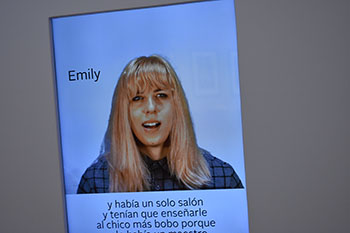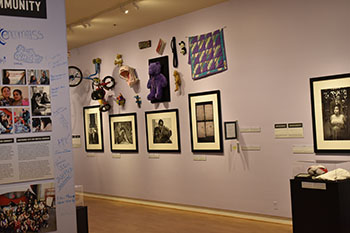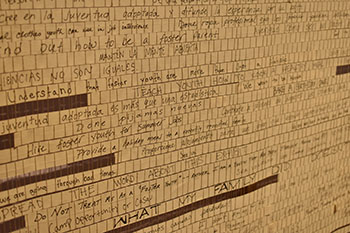Visitors who enter the exhibition “Lost Childhoods: Voices of Santa Cruz Foster Youth” at the Museum of Art and History (MAH) in downtown Santa Cruz become immersed in a world of stigmatized and often rootless children, struggling to avoid homelessness and making their place in the world.
In one corner of the exhibition gallery, museum goers contemplate a series of projections against a bare wall. The moving images look like wood-cut prints: a house disintegrates in a fierce rainstorm, a hoodie-wearing youth stares into the distance, tumbleweeds pile against a barbed-wire fence, and lighting strikes an isolated cabin.
This vivid stop-motion-animation display is the work of Bridget Henry (Porter ’95, art), one of the UC Santa Cruz alumnae who collaborated with Santa Cruz County foster youth on the exhibition.
In imagining this artwork, Henry worked closely with foster youth, whose life stories inspired the metaphorical images on the wall.
That spirit of personal and artistic cooperation infuses the entire exhibition, the result of a partnership between MAH and the Foster Youth Museum, a traveling collection of art and artifacts made by current and former foster youth.
The exhibition, which runs through December 31, draws attention to 60,000 youth in California’s foster care system, while highlighting the creative contributions of foster youth in the Santa Cruz area. In fact, 61 local youth were involved in the planning process.
Several other UC Santa Cruz students and alumni were also involved in the exhibition, including Collegiate Fellows of UC Santa Cruz’s Smith Renaissance Society, which provides a sense of belonging, academic support, social and financial assistance to UC Santa Cruz students lacking family guidance, including current and former foster youth.
The Smith Society provides a pathway to admission for these students, offers support while they are attending UC Santa Cruz, and maintains a growing network of “Senior Fellows” after they graduate.
Three Smith Society collegiate fellows serve as docents for the show, and have provided information to thousands of visitors since the exhibition launched in July, said Shawn Cervantes (Oakes, '13, psychology), Smith Society lead volunteer.
One of the exhibition organizers is another alumna, Jamie Lee Evans (Kresge ’89, sociology), director of training at the California Youth Connection (CYC), a youth-led organization that develops leaders who are helping to transform the foster care system.
Organizers and contributors say the exhibit, the longest-running show that MAH has ever had in its largest gallery, offers a vivid and intimate look at a population that is all too often stereotyped and stigmatized. In “Come Closer,” an HD video and audio installation by Nada Miljkovic (MFA '09, digital arts and new media), former foster children defy labeling by sharing their stories of identity and survival. The video shows their faces in close-up, their eyes gazing directly at the viewer.
One interview subject, only identified as Tiffany, spoke of her endless struggle to “fit into my environment” in various households.
“I didn’t feel pretty,’’ Tiffany said. “I didn’t feel smart. I was not encouraged to go to a four-year university. That was really hurtful, that they didn’t believe in me.” But Tiffany’s tone changes later in the interview. “There is a light at the end of the tunnel,’’ she said. “You are in charge of your own happiness.”
Miguel, another interview subject in “Come Closer,’’ commented about the ways that intact, healthy families empower children to make their own mistakes.
“When you are in the foster care system, they are not going to let you make your own mistakes,” said Miguel, who serves on the CYC’s board of directors. “We don’t have parents a lot of the time. We already don’t have power. We don’t have the power to make our own mistakes and make our own successes, and then we get dinged for not having that power to begin with.”
The themes of hope, despair, making your own future, and fighting back against stereotyping also come into play in “Interwoven Voices,” an installation by Melody Overstreet (Oakes '10, art and psychology).
This artwork is made with drywall tape, linen, strips of paper, and ink. On each strip is a hand-written testimonial, plea, or bold statement from a foster youth that participated in Overstreet’s project. “Don’t criminalize us,” one paper strip reads. Other strips have brief and urgent messages: “Don’t label me,” “We are not bad kids; we are going through bad times,” and “Try seeing the world through the lens of foster youth.”
The Smith Society is hosting “A Night at the MAH” at the museum on Thursday, October 12, at 7 p.m. The event includes the opportunity to tour “Lost Childhoods” and meet some of the artists and students who created the exhibition. This fundraiser will benefit the Page and Eloise Smith Scholarship Endowment, which supports Smith collegiate fellows with financial awards to pay for tuition and related expenses. If you would like to be added to the guest list for this event, please email Shawn Cervantes at skcervan@ucsc.edu
All donations will be matched, dollar for dollar. Leveraging $200,000 in matching funds provided by four lead donors, a successful challenge will create dedicated, perpetual funding for $1,000 minimum scholarships, plus a research fellowship, for at least 20 Smith Collegiate Fellows every year.
Those who wish to give to support the scholarship endowment may also contribute online.





